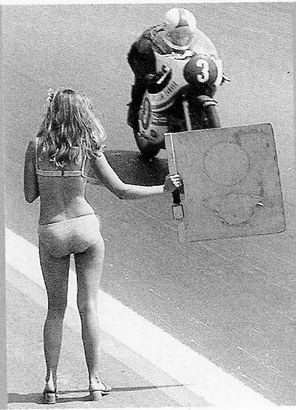JARNO SAARINEN
Indisputably one of the greatest breakthroughs in modern
motorcycle racing was Jarno Saarinen's rotate, hang-off and
dragging-the-knee style — he was in fact the very first to
consistently drag his knees through the turns. There are many other qualities of this Finn which will sooner or later elevate him to
the all-time Champions — for example, he won the Daytona-200 in
Florida on a machine half the size of the competitors, and he even
managed to lap them! He also intimidated the factory riders on
the GP circuit by clinching the 1972 championship as a privateer, and
in the process broke lap-records practically everywhere he went.
Jarno was also his own mechanic and helped modifying and developing
the bikes according to this new style of riding — a style which
later became the norm for most racers still to this day.
In order for Jarno to ride his "hang-off" style, he lowered the clip-ons (handle bars) and excessively angled them downwards. Initially he got this from
his previous experience as an Ice Racer in Finland before he started road racing. (After Jarno's death, Kenny Roberts adopted this style and perfected it
for road racing.)
Sadly, all this was cut short on May 20th 1973 at the Monza race track
— and this simply by an unfortunate officiating mistake (or pure arrogance) when not black-flagging
the race after a bike in the previous race had dumped oil all over the
track, (also 350cc champion Renzo Pasolini died in this crash).
On a personal note; that very day I cried for the first time due to someone's passing, (and
later got a tattoo in honor of Jarno's passing on May 20th).
Jarno was also very popular in Italy where his first name was given to
many newborn boys in the '70s. One of them is former Formula-1
driver Jarno Trulli ... and that's also what I'd name my kid (even if it's a girl ;-)
"I want to live to be a very old man", Jarno Saarinen joked a year
before his death. "If I win a world title I will definitely
retire." However, after winning the world title, he neither lived to
be old nor retired. The 1973 Italian Grand Prix at Monza, May
20th, the fourth World Championship round of the season, was a farce
with tensions running high from the start: The armco fencing was very
unpopular, even with hay bales, and the track had been re-surfaced
carelessly. In addition to this, the race officials decided to
run the race without the two chicanes which were built one year
earlier, (one placed in the entrance of the so-called Curva
Grande). In the 350cc event, running before the 250cc, Villa's
Benelli began losing oil. His team encouraged him to go back onto the
track since there was only one more lap to complete. He cruised
around to finish fifth, dropping oil onto the track in the
process. A journalist, Christian Lacombe, was concerned at the
amount of oil visible on the track and approached the track marshals
to clean it up. Instead they called the police and threatened him
with ejection from the circuit. Also the Australian rider John
Dodds confronted the track official of the course, pointing out the
poor condition of the track — also he was threatened with the
police. Shortly thereafter, John warned as many riders as
possible, but never got to speak with Jarno nor Pasolini. It was
inconceivable that anyone would have started this race, but in those
days riders didn't have a representative and were not used to challenging
authority. Disaster struck almost immediately as Pasolini hit the
oil in the first corner, the super fast Curva Grande, and fell
fatally. Saarinen, following closely, could not avoid him and
also fell. Hideo Kanaya missed the fallen riders but hit the
straw bales full on. In all, 14 riders were embroiled in the
mayhem that resulted. When the dust cleared, Jarno and Pasolini
laid dead with many other riders seriously injured. Although the
shock was total, the race organizers took another two laps before
stopping the event. Chas Mortimer, the only crashed rider who managed to
take to foot, said afterwards; "I went over to help Jarno but wished I hadn't — it was
horrible."
Not only did this incident take the lives of the two
top competitors, but after the race the factory-teams of Suzuki, MV
Agusta, Harley, and Yamaha all joined together to fight for better
race conditions. Yamaha went even further by pulling out of
racing the rest of the year. However, only forty days later,
three riders in a National Juniors race were killed in the same turn.
From that day until 1981 all motorcycle racing at Monza were
banned. The tragedy saw the end of a racing regime which had not
adjusted to changing times. [The last paragraph is based on
combined information by Don Emde, Murray Barnard, and Fabbi Studio]

Jarno Saarinen at Silverstone — 1972
|

Jarno modifying his clip-ons
|

Jarno and wife Soili Karme
|

Jarno's fatal crash at Monza — 1973
|

Jarno and wife Soili Karme — 1970
|
| |